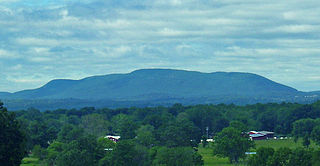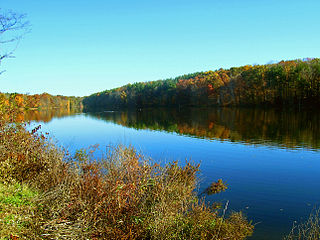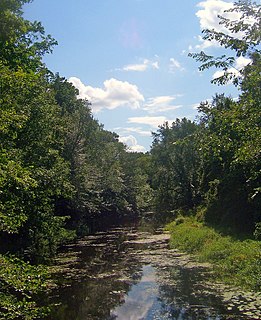
Cornwall is a town in Orange County, New York, United States. As of the 2010 census, the population was at 12,646. Cornwall is located about 50 miles north of New York City in the Hudson River Valley on the western shore of the Hudson River. Cornwall has become a bedroom community for area towns and cities including New York City. Commuter rail service to North Jersey and New York City is available via the Salisbury Mills–Cornwall train station, operated by NJ Transit in behalf of Metro-North Railroad that is part of Metro-North's "West of the Hudson" service. The town is located less than an hour from the George Washington Bridge with access to major commuter routes like the New York State Thruway and the Palisades Parkway.

New Windsor is a town in Orange County, New York, United States. The Town of New Windsor is in the eastern part of the county, bordering the Town of Newburgh and the City of Newburgh. The population was estimated at 25,244 in 2010 by the US Census.

The Moodna Viaduct is an iron railroad trestle spanning Moodna Creek and its valley at the north end of Schunemunk Mountain in Cornwall, New York, near the village of Salisbury Mills.

Schunemunk Mountain is the highest mountain in Orange County, New York. The 1,664-foot (507 m) summit is located in the town of Blooming Grove, with other portions in Cornwall and Woodbury. The community of Mountain Lodge Park is built up its western slope.

The Salisbury Mills–Cornwall station is a commuter rail stop on the Metro-North Railroad's Port Jervis Line, located in the Town of Cornwall in Orange County, New York. Travel time from there to Hoboken Terminal, 55.4 miles (89.2 km) away, is about one hour and 20 minutes.

Browns Pond, in the Town of New Windsor in Orange County, New York, United States, is the smaller of two reservoirs for the nearby City of Newburgh. The 0.3 square mile pond is hook-shaped, with the circuitous Mount Airy Road running past both ends.

Moodna Creek is a small tributary of the Hudson River that drains eastern Orange County, New York. At 15.5 miles (25 km) in length from its source at the confluence of Cromline Creek and Otter Kill west of Washingtonville, it is the longest stream located entirely within the county.

Mountainville is a hamlet in the western section of the town of Cornwall, in Orange County, New York, United States. It is mostly wooded, lightly populated area, located in the narrow valley of Woodbury and Moodna creeks between Schunemunk Mountain and the Hudson Highlands. The New York State Thruway and NY 32 run through the hamlet. It has the ZIP Code 10953.

Glenmere Lake is a colonial mill pond or reservoir located in Orange County, New York, United States. It is New York State's largest habitat of the Northern Cricket Frog, listed as endangered by the New York State Department of Environmental Conservation.
Black Meadow Creek is a 9.7-mile-long (15.6 km) tributary of the Otter Kill in Orange County, New York, in the United States. Via the Otter Kill, it is part of the Moodna Creek watershed, flowing onward to the Hudson River, in one of New York State's most biodiverse natural areas. Home to 13 species of salamander as well as to New York's largest population of the Northern Cricket Frog, the state's only listed "Endangered" frog species, the creek area is considered by biologists to be one of the state's herpetological "hot spots". Black Meadow Creek has several confirmed bald eagle nests along its length.

Otter Kill is a 16.0-mile-long (25.7 km) tributary of Moodna Creek that flows through central Orange County, New York, in the United States. Via the Moodna, which it forms at a confluence with Cromline Creek north of the village of Washingtonville, its waters eventually reach the Hudson River.
Moodna bisinuella is a species of snout moth in the genus Moodna. It was described by George Hampson in 1901 and is known from Mexico.
Moodna clitellatella is a species of snout moth in the genus Moodna. It was described by Ragonot in 1888, and is known from Peru.
Moodna olivella is a species of snout moth in the genus Moodna. It was described by George Hampson in 1901 and is known from Brazil.

Moodna ostrinella, the darker moodna moth, is a species of snout moth in the genus Moodna. It was described by James Brackenridge Clemens in 1860, and is known from North America, including Alabama, Florida, Illinois, Maine, Maryland, Massachusetts, Michigan, Minnesota, New Brunswick, New Jersey, New York, Ohio, Oklahoma, Ontario, Pennsylvania, Quebec, South Carolina, Tennessee, Texas and West Virginia.
Moodna pallidostrinella, the paler moodna moth, is a species of snout moth in the genus Moodna. It was described by Herbert H. Neunzig in 1990 from Big Pine Key, in the US state of Florida. The species has a wider distribution though, including Florida, Georgia, Maryland, New York, Ontario, South Carolina and Tennessee.

Scopariinae is a subfamily of the lepidopteran family Crambidae. The subfamily was described by Achille Guenée in 1854.












